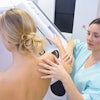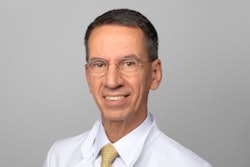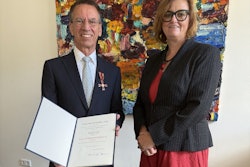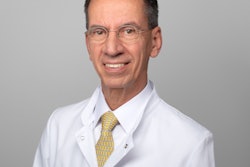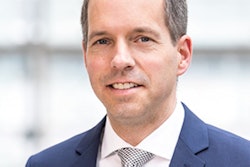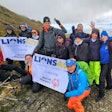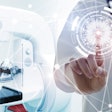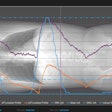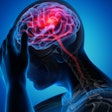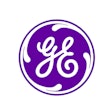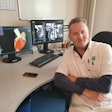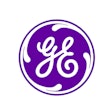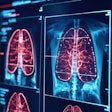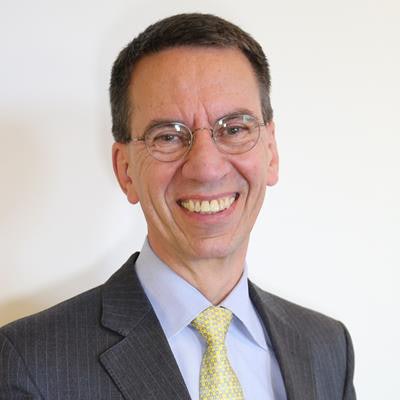
At the end of 2022, Prof. Dr. Bernd Hamm will relinquish his post as director of the department of radiology at the Charité in Berlin, one of Europe's largest university hospitals. He will move into retirement -- and a senior professorship role.
Hamm initially began his training in pathology in 1978 and then switched to radiology. Since then, he has been president of the European Society of Radiology and the German Röntgen Society (Deutsche Röntgengesellschaft, DRG), and he has held numerous other professional and honorary positions. Most recently, he initiated the Radiological Cooperative Network, RACOON.
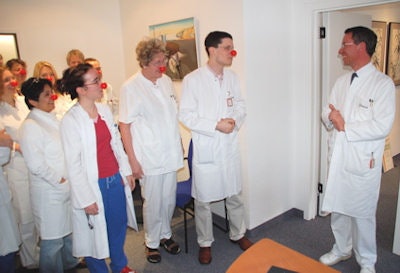 Red-nose radiology: Staff in Hamm's department at the Charité enjoy a lighter moment.
Red-nose radiology: Staff in Hamm's department at the Charité enjoy a lighter moment.In this Q&A interview with the DRG, Hamm looks back on his career as a radiologist and looks forward to the future.
Q: As a medical student, why did you move to Berlin from your hometown of Frankfurt am Main in the early 1970s?
A: At the age of 18, you want to leave home. It was clear to me that I wanted to go to a big city, and Berlin had always been attractive to me, also because we had studied Berlin's history a lot at school. In fact, I left for Berlin right after graduating from high school and ended up being "stuck" here!
Q: Were you also interested in politics in Berlin at the time?
A: I was indeed politically involved as a student representative. Berlin was generally an exciting place. I was always asked: Isn't it a strange feeling to be walled in? It didn't irritate me at all that there was a wall around the city. What mattered was what was happening in the city, and that was a fine thing for students.
As a student, you're not looking for the peace and quiet of a walk in the woods.
Q: Why did you decide to specialize in radiology after your medical studies in 1978?
A: That's also easy to answer. Even at the age of 12 or 13, I wanted to become a radiologist. That had to do with the fact that after school I often went to visit my father, who ran a radiology practice in the hospital. That's when I saw what he was doing. I felt that his work fulfilled him and that he had a lot of empathy for the subject. I thought that radiology would suit me.
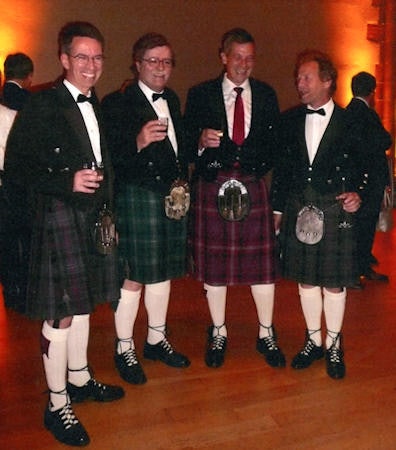 Board members of the European Society of Urogenital Radiology (ESUR) wear their tartan kilts with pride at the ESUR's annual meeting in Edinburgh, U.K., in 2012. From the left are Drs. Bernd Hamm, Lorenzo Derchi, Michel Claudon, and Nicolas Grenier.
Board members of the European Society of Urogenital Radiology (ESUR) wear their tartan kilts with pride at the ESUR's annual meeting in Edinburgh, U.K., in 2012. From the left are Drs. Bernd Hamm, Lorenzo Derchi, Michel Claudon, and Nicolas Grenier.Q: Should radiologists be involved in professional politics?
A: Absolutely! Radiology is not adequately represented politically and in public perception. Yet our specialty is developing rapidly in diagnostics, therapy monitoring, and image-guided minimally invasive therapy and acts as a central hub of medicine. Of course, there is always competition between disciplines -- not primarily scientific, but professional. We must continue to strengthen our discipline and make it visible so that it remains attractive to the next generation.
Q: Can you tell us about your research collaborations?
A: We are currently working on a project with other sites on multiparametric MRI of the prostate. We also have a Horizon 2020 project looking at AI in oncology and two very large multicenter studies on cardiac imaging. I have to add a caveat: I am not the principal investigator on many of the projects. It is the members of my team who initiate and successfully implement such projects. My function is to enable and support this.
Q: What were your activities in the German Research Foundation (DFG)?
A: I was a review board member at the DFG for a total of eight years (partly with two other radiology colleagues). There, we reviewed proposals ahead of funding decisions. It is essential for our discipline to be represented at the DFG so that the voice of radiology is heard. At the moment, we have no representation there, but hopefully this will change in the next election.
Q: In your own research projects, you were often interdisciplinary and intercultural. How important are these values to you?
A: It enriches scientific work immensely when you work in an interdisciplinary way because you get other perspectives on a topic. In this context, our collaborative research center "Matrix in Vision" is particularly exciting. Here we work in a highly interdisciplinary way, together with representatives from basic research, chemistry, physics, and, of course, diagnostic radiology. Together, you can make things happen that you can't achieve in one subject alone. It's clear that science benefits from looking at challenges from different perspectives and in different cultural contexts.
Q: Which of your research projects are you particularly proud of?
A: A real bombshell was the development of the drug-eluting balloon catheter, which I did not develop but which was created in our research department. It is now used all over the world. "Matrix in Vision" also is working on noninvasive imaging of the extracellular matrix. The cooperation and exchange between basic sciences, imaging and clinical research is extremely stimulating and at the same time a motor for new ideas.
Q: You co-initiated and now coordinate the Radiological Cooperative Network, RACOON. What potential do you see in this project?
A: RACOON is sensational in that we have succeeded, together with Prof. Vogl from University Hospital Frankfurt am Main, in including all of our university radiology departments in the project without exception. This significantly increases the visibility of our discipline. We are making good progress in RACOON in pandemic analysis and perhaps pandemic preparedness for the future. With the infrastructure of RACOON, we have a unique opportunity to join forces on other issues in the future, for example, in oncology or rare disease analysis.
Even here at Charité, there are diseases that occur only three or four times a year. If information were to come from all the other university radiology departments, we would have a lot of good data in one fell swoop. We can now implement all of this with the infrastructure created by RACOON.
Q: Which topics will be decisive in the future?
A: Radiology is one of the most innovative subjects in medicine. Of course, this is related to the fact that new technical developments are quickly transferred into clinical practice. A very important point for the future will be the further development and expansion of interventional radiology, since it is a mainstay of therapy, in addition to diagnostics. Our field impresses with its phenomenal thematic diversity, and AI will play a major role in this in the future. I don't see AI as a threat but as a support for what we do. Perhaps it will also help us gain more time for direct patient contact and treatment.
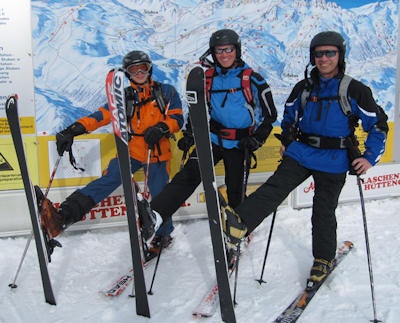 Outside of radiology, Hamm loves to relax and unwind by skiing with his two sons Charlie and Colin.
Outside of radiology, Hamm loves to relax and unwind by skiing with his two sons Charlie and Colin.Q: What advice would you give to the next generation of radiologists?
A: All I can say is the breadth of the field is fascinating! As a result, you always find what interests you. As far as science is concerned, the most important thing is to take a lot of interest in new things. And don't let initial failures set you back. You need a certain marathon mentality, then the rest comes almost by itself.
Editor's note: This is an edited version of a translation of an article published in German online by the DRG. Translation by Frances Rylands-Monk. To read the original longer version, go to the DRG website.


